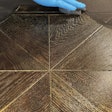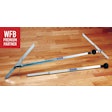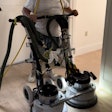The Problem
I received a call from a contractor who wanted me to take a look at a wood floor he had recently completed. The floor was about 3,000 square feet of 2 1/4 inch red oak strip in a new home. The crew had installed the floor, sanded it and applied four coats of waterborne urethane.
Six weeks after the family moved in, the contractor received a call from the homeowner. She said that the floor was scuffing and scratching easily throughout the home, and when the floor was cleaned, it lost its shine.
The Procedure
The contractor was sure that the crew had followed all the correct procedures. The crew allowed time for the wood to acclimate on the job site, checked the moisture conditions of the subfloor and flooring to make sure they were in an acceptable range, and then installed the wood floor over a plywood subfloor with a moisture barrier. They then sanded the floor with 40-, 60- and 100-grit paper and screened it with 100-grit screens. They sealed the wood with a waterborne sealer and topcoated with three coats of a twocomponent waterborne finish, allowing enough time between coats for the finish to dry and using maroon pads to abrade between coats. All coats appeared to dry as expected and looked normal.
The Cause
As we inspected the house, we did see an excessive amount of scuffs and scratches throughout the home. Some areas were dull, apparently from cleaning (a quick glance under the sink revealed a recommended hardwood floor cleaner). These problems could be an indication of coats that were too thin, not enough coats, bad maintenance practices, insufficient dry time or not using a catalyst when it's required.
We had seen a similar situation not long before involving a gym floor, and it had turned out that the lead floor sander left halfway through the final coat. After the floor was complete, the floor soon showed excessive wear only on the section that was completed after the lead floor sander left. His helper had finished the remainder of the floor, forgetting that he had to use the catalyst.
Suspecting a similar situation, we checked several test areas, including closets, inside a pantry and under several air vents by using some M.E.K. (Methyl Ethyl Ketone) on a cloth and rubbing the finish. The finish immediately became soft, possibly indicating that either no catalyst or not enough catalyst was added to the finish.
After we explained the situation to the contractor, he talked with the worker who had finished the floor, who happened to be one of his newer employees. It turned out the employee had experience with waterborne finish, but he had never used a two-component product. So, he hadn't realized he needed to use a catalyst in the finish.
How to Fix the Floor
In cases where the scuffing is deep and severe, total resanding and refinishing may be required, but in this case, we were able to simply repeat the finishing steps correctly. First, the crew took moisture readings to ensure that the wood floor was still at an acceptable moisture level. Then, they abraded the floor with a maroon pad and refinished the floor with properly catalyzed finish, resulting in a finish that would have build and provide resistance to both wear and chemicals.
Unfortunately, the contractor had to pay for all the furniture to be moved in and out and for the family to stay at a hotel while the floor was being refinished. He also was left with a customer who was extremely unhappy about the hassle and inconvenience caused by her wood floor problems.
In the Future
When you take into consideration the multitude of finishes on the market today, it isn't a surprise that many job-site mistakes involve something to do with the finish or the finish application. Even similar types of products can have different directions, spread rates or application techniques. Confusion regarding catalysts and cross-linkers is especially common. When contractors try any new product, no matter how similar it seems to other products they know, they must read the directions. We recommend that contractors read the directions and then read them again to make sure they understand the procedure. When in doubt, they should always call the manufacturer or the National Wood Flooring Association for technical help.
As this example illustrates, even if you know the proper procedures and recommendations for each product you use on the job site, that doesn't mean everybody on your crew does. It's a good idea to have regular refresher training for the whole staff, either with a lead worker from your company or with the manufacturer's sales rep from your area. Remember, educating yourself and your crew is the recipe for success.
































